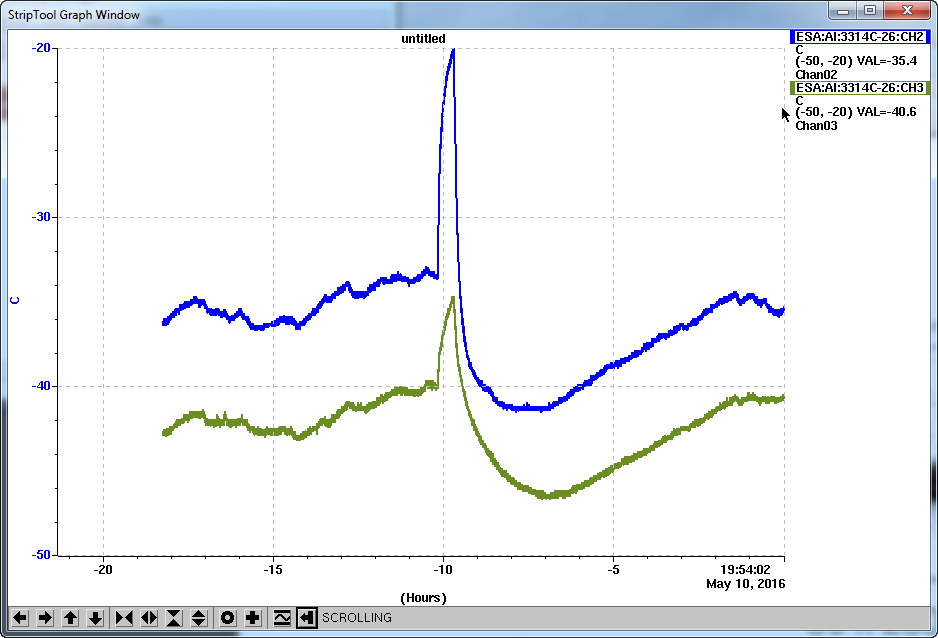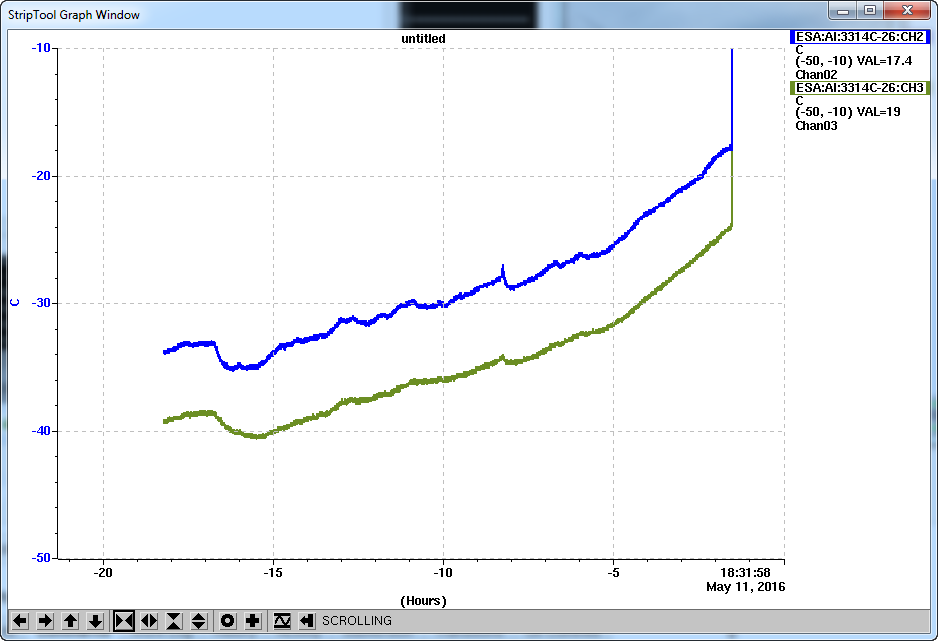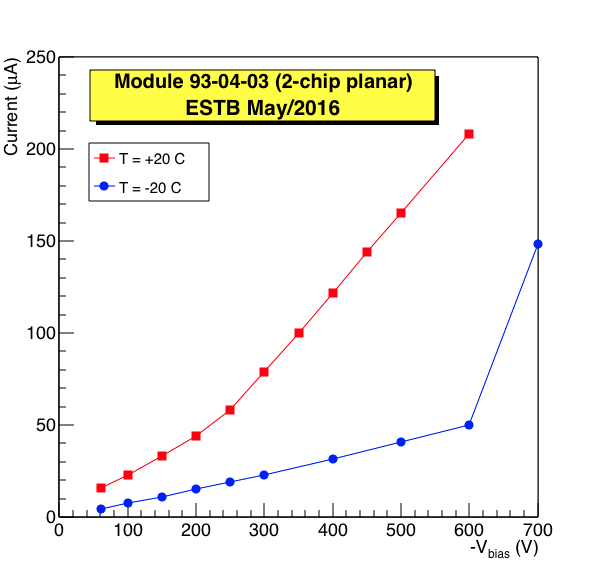ATLAS twiki page for T539: https://twiki.cern.ch/twiki/bin/viewauth/Atlas/RadDamageTBSpring2016
Event Log
- May/5:
- Plugged in the beam trigger BNC cable to the TLU PMT trigger and ready for beam.
- MCC complained not all doors were shut. Both small door and the fence gate in the ESA entrance alley need to be closed. Hall light all went dark after doors closed. Tonee brought back tunnel lights from MCC upon seeing our E-mail, so we can now see all the web cams again.
- First attempt to send beam. Tonee tuned to ~4 electrons/crossing with 11 GeV beam @5Hz.
- Starting Caladium position was close to be centered vertically but ~10cm off horizontally (towards ESA entrance side). Mike helped to get the position adjustments with his new Beckoff 26 (B061 Calladium) panel (Motors section). Moved at ~10mm steps to "RBV from step: 101.72mm" (with >) which the overhead CAM05 shows is moving away from ESA entrance as hoped.
- Mike set the trigger to chan 7 (ESA User 3 TTL) initially but that didn't trigger EUDAQ. He switched that cable to chan 10 (Silicon Tracker - Calladium (NIM)) and used the last Jan/2016 setting of width=200, delay=-104950. This got beam triggers going in EUDAQ and datataking with ni_coins.cfg now getting real beam hits on Calladium.
- Run 148-150 showing a rectangular beam spot width of (DX,DY) ~ (120,230) which is ~(2mm,4mm). (MIMOSA has 18.4um square pixels with X,Y range 1152,576). The centroid of the front 3 planes are at (180,280), and the back 3 planes are at (330,140). The front and back plane groups are ~70cm apart in Z. The tilt is (+150,-140) or (2.8mm,-2.6mm), which is ~4mrad tilt. There is no vertical tilt adjustment but there is a manual knob for horizontal tilt (around Y-axis).
- Stopped Run 150. Attempt to move telescope. Y fine abs position 45.0->43.7mm. X fine 65.0->59.5mm these didn't matter (they are for DUT only). Coarse Y set=0. bottomed out but still not quite low enough. Coarse X abs pos 100 to 96.
- Tried to get operator to enlarge the beam spot but nothing seemed to make much difference, but upon restart after access, the spot went to almost full aperture of 1.5mm wide in X and 0.5mm high in Y. No clear what helped that.
- Martin checked the double chip module threshold scan with 50V bias at Lab1. Threshold and noise very uniform with only sprinkle of misbehaving pixels.
- Moved in DUT hardware with an access:
- New reference planar 2-chip module 930304 installed as DUT in vertical frame directly mounted on the rotation stage.
- New shield heavy gauge long LV cable to PSU with Vset=1.5 (lab test showed currents up to 0.65A). This is a special direct power module requires Vset not exceeding 1.5V.
- Threshold scan worked well in Lab1 with a -50V HV, but had trouble to turn on the BK Precision 1697 supply (+ve and GND ganged to supply -ve HV) which could only go up to 40V max in any case (Martin thinks unirradiated planar may still need ~60V to be sure).
- A new HSIO-II installed on top shelf with the new 18 port RJ45 pixel interface for DUT DAQ. Its 18th port is connected to TLU DUT 1.
- Two output data channels of the pixel module connected to HSIO-II interface ch 0 and 1 respectively, but swapped in green cable from web cam and orange cable on a table (not sure if it works) for data links.
- Don't have proper CAT6 cables to ground HSIO-II against supplies. Still needs a dedicated ground cable from HSIO-II to PSU.
- A new Sun server from Lab1 packaged to serve as DUT DAQ host node is shipped into ESA and installed into the Calladium rack. It comes in as a replacement node for esa-user12 172.27.104.42 and with same common operation user account tbslac as for esa-user02. The private ethernet link to HSIO-II recognizes HSIO-II as rce0. Boot up has some trouble in ESA: not able to startx.
- A microUSB hub added to lead out the single USB port on esa-user12 for 3 different purposes: keyboard, mouse and microUSB link to HSIO-II UART port.
- End run 164 before beam went away. Saved a copy of monitoring plots at /home/tfuser/Desktop/2016May_onlinemon//run164.root which probably contains plots from Runs 162-164.
- May/6:
- Matthias looking into the why the new Sun server (esadutdaq1 172.27.104.45) doesn't come up in 172.27.104.x ESA-RESTRICTED subnet with Mike. First simple problem found was the two ethernet connections on the Sun server was swapped. Network should be on top port, RCE link should on bottom port. For the 2nd more exomplex issue, we traced the two ethernet cables from Mike for Calladium rack: Cable 2 connected to Sun server is on Belgen patch panel ch 19; cable 3 connected to NI crate is on Belgen ch 20. In the SWH-B061 rack in the middle ESA, we saw Belgen ch 20 is connected to SW port 32 which is on the 104 ESA-Restricted subnet so that the NI crate has been OK all along. However, Belgen ch 19 was connected to SW port 21 which is on the 100 ESATESTFAC subnet. This also explained why esa-user02 appeared to have worked, but we could not ping NI crate. Once Belgen ch 19 is redirected to SW port 33, everything worked. There is still an issue with the Sun server esadutdaq1 so that the console can only be a dumb monitor but mouse and X don't work.
- Installed a NIM crate with Dual port negative 0-2KV HV supply. Used AVO on Lemo monitoring port to guide he setting to -60V on ch A for sensor bias.
- Added ground clip between HSIO-II DGND and LV supply -ve GND. Added a LEMO cable between HSIO-2 LEOM ch-1 and TLU TTL trig1 for TLU ground (would not need this if the DUT producer cables was a full CAT6 with ground plate).
- Created a new configuration /home/tfuser/eudaq/conf/SLAC_1dut_FE14B.conf for the 2-chip module 930304. DUT config/calibration taken from moduleconfig/93-04-03/configs on esadutdaq1 under the tbslac account.
- Initial DUT datataking with EUDAQ worked but stone quiet with no hits (not timed in yet).
- Started DUT timing scan by requesting a hotter beam of ~100 hit pixels / crossing. Trigger ch 11 initlal delay=-104950. DUT DAQ window is 16*25ns and we used 300ns steps. going +ve to -94500 saw nothing, but going down to -110488 settled the DUT data on time sample 8.
- Beam spot looks like 100x250um=25mm wide in X and 100x50um=5mm tall in Y, horizontally very well centered between the two FE-I4 chips in the middle of the sensor. With anticipation of titled data across most of the Y range, we make 2.5mm Y adjustments between runs to cover the full Y range in this central X band. DUT getting ~7 pixels hit (~5 particles) per event. Runs 176-186, varying between 10K events per run earlier to 3K events towards the end to hurry before beam off.
- Primary beam energy changed 14->12 at ~8pm while the secondary beam energy to ESA still at 11 GeV but with a different tune. This happened in the middle of Run 185 at y=51.20.
- Some operational notes: event data files not closing properly when reached max event limit. Changed max event limit in config ffrom 10K to 15K. every time ended a run, must configure again before restart another run or there will be no triggers.
- May/7:
- LCLS primary beam back up to 14 GeV so we recalled the beam setup we had for this primary energy as of 8pm yesterday before the primary energy drop. Started Run 187 with the same DUT position as we left at last night of Yfine=93.7mm to get higher stat cleaner data here.
- Started Run 188 with Yfine=91.2mm to add cleaner statistics here and use this spot as a reference region as starting point for threshold changes.
- Run 189 down to Yfine=41.2 to cover the missing bottom region (file closing error).
- Started to play with threshold scans by importing a suite of tuning with different thresholds from Rebecca. The scan results on the 2nd channel came out consistent with the targeting thresholds (threshold mean value ~10% below target), but chan=0 consistently giving ~factor of two higher thresholds (or a large offset). The threshold setup from Martin we ran yesterday is giving consistent thresholds for both chips at ~3000e.
- Run 190 moved up to a central region with Yfine=46.2 and used the 1000e threshold setting from Rebecca (knowing chan 0 and 1 might behave differently) to take some low threshold data to see what happens. MIMOSA data showing beam spot running over the right X edge.
- Run 191 moved the whole telescope+DUT Xcoarse from 95.5 to 98.0 (+2.5mm). MIMOSA better centered, DUT Xmean moved to 67 from the center point of 80 (more data on chan=0 than chan=1).
- During Run 192 tried to move DUT Xfine by -2.5mm but it responded with a smaller move than expected from abs Xfine control even all the way to 0. Still responds to relative adjustments but the steps are certainly not as large as claimed either which seems a factor of 5 to 10 finer than the actual scale. Centered DUT but the abs position becomes meaningless.
- Ben tried manual calibration and got a good 2000e threshold setting (target Q=11000, TOT=8). Run 193 with this 2000e threshold for last perpendicular data.
- Controlled access into ESA to turn the module by 90 degrees. Had to remount the frame towards one side to avoid cables on the side colliding with telescope plane when rotated.
- Upon restart, MIMOSA plane 4 was not responding. The speedo meter NI screen showed plane 4 mask as fffffff and Caladium power supply current down to 3.31A. Did a cold start for Caladium and that brought current back to 3.56A and plane 4 is back.
- Run 198 see streaks close to expectation. 13 pixel streaks says the tilt was ~71 degrees.
- Run 199 tried to rotate a bit further and streak peak ~ 15 pixels (~73 deg).
- LCLS wants to switch beam energy at 7:30pm - end of today's program.
- May/8:
- Took two last reference 0 degree runs (187-193) with various threshold tunings.
- Adjusted telescope to not run into MIMOSA edges.
- Module rotated to steep angles remotely first to 71 deg and then tweaked to ~73 deg (angle estimated based on cluster length).
- May/9:
- Continued with a few more room temperature tilted runs. Impossible to get the module chan0 to tune below 2000e so that Runs 202-204 had split thresholds with chan 0 remained on 3000e, while chan 1 threshold varied between 1000e to 1500e. Run 204 also increased bias voltage from -60V to -200V.
- Not sure why HV current measuring 16mA while was 4 mA earlier at the same voltage of -60V. Did a quick IV scan.
- Moved 93-04-03 into cooling box. Long module card makes it impossible to run vertically or horizontally in the middle chamber. Has to remove one cooling partition and tilt sensor to ~45 degrees to find space for cables. 9ft cables are also marginal in length and had to run under the cooling box. Put two Caladium NTCs in, one hanging next to module "air" and one stuck on base block. Filling dry ice to start codlin at 2:30pm.
- Recheck of HV found very low values and discharging quickly to zero. Swapped several HC modules and all had similar trouble. Realized that NIM crate failed. Because we didn't run a fan for it ? Stole a NIM crate from ESA middle rack and its fan. Back in business again.
- Temperature came down to -30C after ~3 hours an continued down to -40C after 4 hours.
- Warm tune doesn't work well cold. Martin obtained a reasonable 3000e cold tune at T ~ -35C for the "air" sensor (temperature still decreasing and sensor may be warmer than air). However, when air temperature really bottomed out slightly below -40C, a lot of noise hits tuned up, especially right edge of channel 0. The ~2000 hits per event crashed the DUT offline producer a few times.
- Tried to align telescope and DUT to beam but couldn't center the DUT. Vertical remote Y adjustment reached limit and has a strange effect of going up initially then slow sags down.
- May 10:
- Left the cold box sealed overnight and bias, LV on. Still at -35C in the morning. Data also looked more normal. So the extra -5C could cause significant noise growth.
- Added dry ice to go down in temperature again. Bottomed out at -42C air temperature after 3 hours. The warm up rate while keeping system running is ~1C/hr.
- The cold box was surveyed and manually repositioned to be close to beam line and that managed to DUT into the window.
- The beam spot was mostly a horizontal rectangle initially. We asked Tonee to tune the beam into a vertical rectangle for more efficient coverage of the tilted configuration. A special configuration was indeed obtained.
- Last run 266 with the vertical beam spot and T ~ -35C.
- Powered off LV, HV, HSIO2 at 8pm.
- May/11:
- Checking the cold box temperature history.
| May/10 operation with dry ice top-off at t=-10hr and regular running -10 to -2hr | May/11 overnight warm up with everything powered off was ~0.4C/hr. The rate almost doubled at t=-5 hr when the sealing tape on the cold box lid fell and lid slightly opened up. |
- Also did an IV curve at -20C before dismantle the setup and compared with the room temperature measurement earlier:
- Also did an IV curve at -20C before dismantle the setup and compared with the room temperature measurement earlier:


